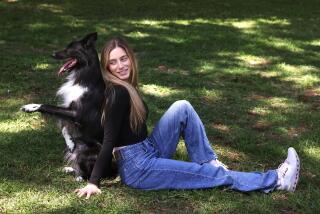If I’m good, will you choose me?
- Share via
BALTIMORE — Saturday is the big day here at the SPCA, temporary home to mutts like me.
At 11 a.m., they open the doors and let the humans in -- big ones, little ones, some alone, some in packs. They stare at us, talk to us in high-pitched voices, stick their fingers in our cages and, if we’re lucky, take us home.
About 7 million animals -- including cats -- pass through U.S. shelters in the course of a year. About half of us get adopted. The other half? You don’t want to know.
Suffice it to say, I really want to get adopted.
They call me Sage.
How did I get here? Let’s just say once I had a home, and then I didn’t. I found myself wandering the streets.
I spent three weeks at the city shelter before being sent here. This is my 10th day at the SPCA and, nice as the accommodations are, I’m ready to leave.
The first weekend, there were no takers, at least not when it came to me. Maybe it was my own fault. I barked -- a lot. I figured that was the best way to get noticed. Maybe I overdid it. Since then, the staff has been giving me treats for being quiet and, being an intelligent sort, I’ve caught on.
This Saturday, I will try a different approach. I will be quiet. I will be still. Demure even. I won’t drool. I won’t shed. I will behave in a manner befitting a 1 1/2 -year- old female Labrador-shepherd mix.
When those doors open, all you other mutts can bark away. Go ahead: Yelp, whimper and howl as if there’s no tomorrow.
Me? I’m just going to sit here and look cute.
*
Between them, Les Farish and Miranda Williams have a house in Essex, two cars, four children and a cat named Dixie.
But, sufficient as that may seem, they’ve been thinking for a good year now that their blended family might need one more ingredient.
So when Williams and the four children arrived at the Maryland SPCA on Falls Road on a recent Saturday morning -- a few minutes before the doors opened -- the biggest decision was behind them.
Adopting a pet can change your life, and animal advocates and shelter officials encourage people to think it through before they become smitten by an animal’s cuteness. One shouldn’t adopt a pet on impulse, they say.
Keep in mind that the adorable bundle of fur is going to pee and poop and shed and drool and bark and eat and cost you about $1,000 a year for the next 10 to 15 years. He or she will need grooming and medical care and exercise, lots of exercise.
Your life is going to be a little less spontaneous, with a few more responsibilities. In exchange, you get true love. Assuming you and the pet bond, you will have a loyal companion who is always happy to see you.
Having had dogs before, Williams and her family knew all that. They had weighed the pros and cons and spent a year talking about it, putting it off until they were settled into their new house. Now they were ready and waiting at the SPCA kennel.
They didn’t have a breed in mind -- just a dog that was not too big, not too small, good with children and, most important to Williams, not too loud.
They wandered up and down the rows, peering into the cages. They checked out Cinnamon, Buddy, Frankie and others. Then daughter Emily, 8, paused in front of a cage.
“Sage is cute,” she said, sticking her hand through the cage and getting it licked.
“She’s really quiet,” Williams said. “That’s good.”
Sage sat still and quiet. But after about a minute, the family moved on.
*
Hold on. Where ya goin?
That looked like a nice family.
Lots of kids, but that’s OK. More people to play with, maybe more people to feed me. I wish they’d come back.
Maybe I should bark after all.
Wait a minute. Somebody’s opening my door and putting a leash on me. Is it time for my walk?
Hey, there’s that family again. Maybe they picked me.
*
“There’s our doggie,” Emily said as an SPCA staff member walked Sage over to the family.
One at a time, the children approached to pet her. She licked each.
“She’s very sweet,” said daughter Cerena.
Dylan, the youngest, pulled her tail. Sage didn’t seem to mind.
“I like her,” said Travis, the oldest.
The staff member took Sage and the family to the fenced-in “fun run” behind the building and let her off her leash. She ran with the children and briefly chased a ball, but soon found herself more interested in the adjoining run, where another dog, Frankie, had been brought out to meet another family.
For five minutes, the two dogs ran back and forth along the fence that separated them, like mirror images of each other.
After about 15 minutes, a staff member put her back on her leash and returned her to her kennel.
*
I blew it.
I shouldn’t have peed over in that corner of the fun run. I shouldn’t have chased Frankie. I should have done a better job of fetching that ball.
I’m never going to get out of here.
*
“So, you guys liked the dog?” SPCA adoption counselor Celeste Nader asked the children back inside the building. They all nodded. Nader opened Sage’s folder and told Williams what she knew of the dog’s background.
She is 1 1/2 years old, 50 pounds and a transfer from Baltimore Animal Rescue & Care, the former city shelter that recently became a nonprofit organization. She had been dropped off there as a stray.
The SPCA uses three categories to classify dogs’ activity levels: “break-dancing wild dog,” “swinging tap dancer,” and “waltzing Matilda.” Sage falls in the middle group. Sage has been spayed, can sit on command and may or may not be housebroken.
“You still want the dog?” Nader asked.
“Yes,” Williams said.
After verifying that the Williams-Farish family owns its home and that its cat is up to date on her shots, Nader returned.
“I’m approving the adoption,” she said. “You can take your dog home today.”
If things didn’t work out, Nader told Williams, she could return the dog within 14 days and get another, or a full refund. She recommended that Sage visit a veterinarian within three days, because dogs in shelters are under more stress and more likely to become ill.
Williams paid the $125 adoption fee, $10 for a license and $15 to get a microchip implanted under Sage’s skin.
*
You know when someone’s leaving here. A voice comes out of the wall and announces it, as it just did for Frankie.
“Frankie, the dog in D-29, to go home, please.”
I’m going to miss Frankie. I’m happy for him.
“Sage ... “
There’s that voice again. Wait a minute, that’s me!
“Sage to the exam room for a microchip.”
A microchip? Is that some kind of treat? I’m not sure I like the sound of that.
“And then to go home.”
*
Her microchip implanted, her temporary leash in place, Sage hit the floor of the SPCA lobby like a cartoon character that couldn’t get traction, slip-sliding her way to her new family.
“Yea!” Cerena said. “We got a doggie.”
Farish took Sage’s leash and they walked to the parking lot.
Sage stopped at the car, looking as if she were having second thoughts. She strained against the leash, but put up no resistance when Farish picked her up and put her in the back of the Durango, where a blanket had been spread across the floor.
“C’mon, girl,” he said. “Let’s go home.”
More to Read
Sign up for Essential California
The most important California stories and recommendations in your inbox every morning.
You may occasionally receive promotional content from the Los Angeles Times.













